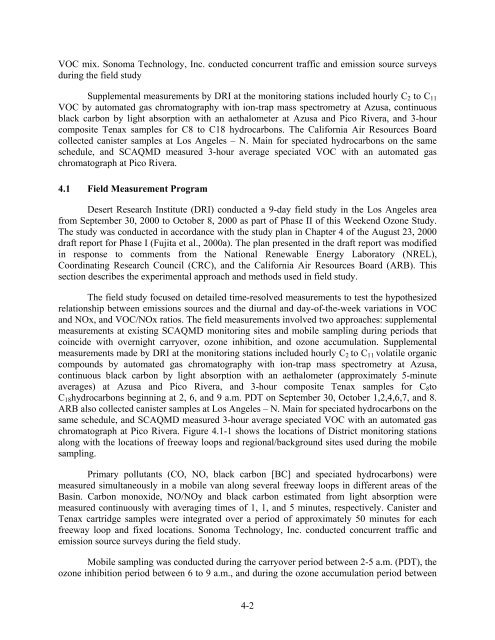Weekend/Weekday Ozone Observations in the South Coast Air Basin
Weekend/Weekday Ozone Observations in the South Coast Air Basin
Weekend/Weekday Ozone Observations in the South Coast Air Basin
Create successful ePaper yourself
Turn your PDF publications into a flip-book with our unique Google optimized e-Paper software.
VOC mix. Sonoma Technology, Inc. conducted concurrent traffic and emission source surveys<br />
dur<strong>in</strong>g <strong>the</strong> field study<br />
Supplemental measurements by DRI at <strong>the</strong> monitor<strong>in</strong>g stations <strong>in</strong>cluded hourly C 2 to C 11<br />
VOC by automated gas chromatography with ion-trap mass spectrometry at Azusa, cont<strong>in</strong>uous<br />
black carbon by light absorption with an aethalometer at Azusa and Pico Rivera, and 3-hour<br />
composite Tenax samples for C8 to C18 hydrocarbons. The California <strong>Air</strong> Resources Board<br />
collected canister samples at Los Angeles – N. Ma<strong>in</strong> for speciated hydrocarbons on <strong>the</strong> same<br />
schedule, and SCAQMD measured 3-hour average speciated VOC with an automated gas<br />
chromatograph at Pico Rivera.<br />
4.1 Field Measurement Program<br />
Desert Research Institute (DRI) conducted a 9-day field study <strong>in</strong> <strong>the</strong> Los Angeles area<br />
from September 30, 2000 to October 8, 2000 as part of Phase II of this <strong>Weekend</strong> <strong>Ozone</strong> Study.<br />
The study was conducted <strong>in</strong> accordance with <strong>the</strong> study plan <strong>in</strong> Chapter 4 of <strong>the</strong> August 23, 2000<br />
draft report for Phase I (Fujita et al., 2000a). The plan presented <strong>in</strong> <strong>the</strong> draft report was modified<br />
<strong>in</strong> response to comments from <strong>the</strong> National Renewable Energy Laboratory (NREL),<br />
Coord<strong>in</strong>at<strong>in</strong>g Research Council (CRC), and <strong>the</strong> California <strong>Air</strong> Resources Board (ARB). This<br />
section describes <strong>the</strong> experimental approach and methods used <strong>in</strong> field study.<br />
The field study focused on detailed time-resolved measurements to test <strong>the</strong> hypo<strong>the</strong>sized<br />
relationship between emissions sources and <strong>the</strong> diurnal and day-of-<strong>the</strong>-week variations <strong>in</strong> VOC<br />
and NOx, and VOC/NOx ratios. The field measurements <strong>in</strong>volved two approaches: supplemental<br />
measurements at exist<strong>in</strong>g SCAQMD monitor<strong>in</strong>g sites and mobile sampl<strong>in</strong>g dur<strong>in</strong>g periods that<br />
co<strong>in</strong>cide with overnight carryover, ozone <strong>in</strong>hibition, and ozone accumulation. Supplemental<br />
measurements made by DRI at <strong>the</strong> monitor<strong>in</strong>g stations <strong>in</strong>cluded hourly C 2 to C 11 volatile organic<br />
compounds by automated gas chromatography with ion-trap mass spectrometry at Azusa,<br />
cont<strong>in</strong>uous black carbon by light absorption with an aethalometer (approximately 5-m<strong>in</strong>ute<br />
averages) at Azusa and Pico Rivera, and 3-hour composite Tenax samples for C 8 to<br />
C 18 hydrocarbons beg<strong>in</strong>n<strong>in</strong>g at 2, 6, and 9 a.m. PDT on September 30, October 1,2,4,6,7, and 8.<br />
ARB also collected canister samples at Los Angeles – N. Ma<strong>in</strong> for speciated hydrocarbons on <strong>the</strong><br />
same schedule, and SCAQMD measured 3-hour average speciated VOC with an automated gas<br />
chromatograph at Pico Rivera. Figure 4.1-1 shows <strong>the</strong> locations of District monitor<strong>in</strong>g stations<br />
along with <strong>the</strong> locations of freeway loops and regional/background sites used dur<strong>in</strong>g <strong>the</strong> mobile<br />
sampl<strong>in</strong>g.<br />
Primary pollutants (CO, NO, black carbon [BC] and speciated hydrocarbons) were<br />
measured simultaneously <strong>in</strong> a mobile van along several freeway loops <strong>in</strong> different areas of <strong>the</strong><br />
Bas<strong>in</strong>. Carbon monoxide, NO/NOy and black carbon estimated from light absorption were<br />
measured cont<strong>in</strong>uously with averag<strong>in</strong>g times of 1, 1, and 5 m<strong>in</strong>utes, respectively. Canister and<br />
Tenax cartridge samples were <strong>in</strong>tegrated over a period of approximately 50 m<strong>in</strong>utes for each<br />
freeway loop and fixed locations. Sonoma Technology, Inc. conducted concurrent traffic and<br />
emission source surveys dur<strong>in</strong>g <strong>the</strong> field study.<br />
Mobile sampl<strong>in</strong>g was conducted dur<strong>in</strong>g <strong>the</strong> carryover period between 2-5 a.m. (PDT), <strong>the</strong><br />
ozone <strong>in</strong>hibition period between 6 to 9 a.m., and dur<strong>in</strong>g <strong>the</strong> ozone accumulation period between<br />
4-2
















